|
Printables |
PowerPoints |
Online exercises |
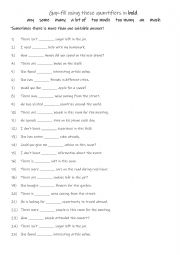
|
A1+-A2 Gap-fill using the 8 quantifiers
Quantifiers help students specify the amount or number of something. This precision allows them to convey their message more accurately. Using a range of quantifiers allows people to vary their language, making speech or writing more engaging and less repetitive. For instance, saying "a few" instead of always using "some" can make your communicatio...
Level: elementary
Age: 8-100
Type:
Downloads: 103
|
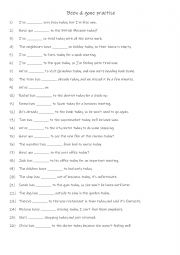
|
A2+-B1 Been & gone practise
Using "been" and "gone" properly helps students master the present perfect tense, which is essential for expressing completed actions that still impact the present.Misusing these words can lead to confusion about whether someone is still at a place or has already returned, so learning the difference is essential for clear communication. Each word i...
Level: intermediate
Age: 9-100
Type:
Downloads: 110
|
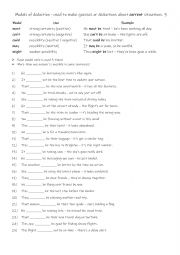
|
Modals of deduction - used to make guesses or deductions about current situations. 3
Students should learn modals of deduction because they are useful for expressing logical guesses or assumptions about present situations, helping speakers show how certain or uncertain they are. These modals, such as must, might, could, and can�t, make speech sound more natural and fluent, improve communication and reasoning skills, and are commonl...
Level: elementary
Age: 8-100
Type:
Downloads: 119
|
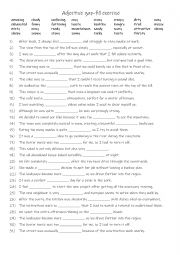
|
A2+-B1 Adjective gap-fill exercise
Students familiarise themselves with the 31 adjectives and their meanings. Then they read the sentences to see which adjective is required to complete the gap-fill.Answers on page 2.
Level: intermediate
Age: 9-100
Type:
Downloads: 104
|
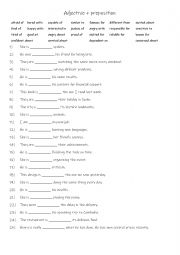
|
A2+-B1 25 Adjective + prepositions
Understanding how adjectives combine with prepositions helps students provide more detailed and precise descriptions. For example, knowing the phrase �interested in� allows you to convey specific interests more clearly.Mastering these combinations contributes to overall language proficiency, allowing you to use English more accurately and confident...
Level: intermediate
Age: 10-100
Type:
Downloads: 117
|
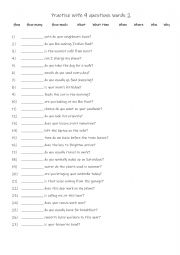
|
Practise with 9 question words 2
Students familiarise themselves with the 9 question words and their use. Then they read the questions to see which question word is required to complete the questions. Answers on page 2.
Level: elementary
Age: 7-100
Type: worksheet
Downloads: 112
|
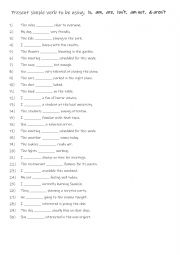
|
A1-A2 Present simple verb to be using is, am, are, isn�t, am not, & aren�t
Students read the sentences to see which form of the verb to be to needed to complete the sentences. Answers on page 2.
Level: elementary
Age: 8-100
Type:
Downloads: 102
|
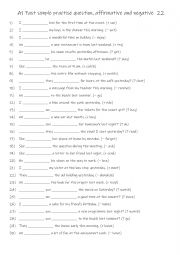
|
A1 Past simple practise question, affirmative and negative 2
Learning the past simple tense with questions, affirmative, and negative sentences is essential for students as it enables effective communication about past events. It provides a foundation for understanding grammar and constructing basic sentences, which is crucial for daily conversations. Mastering these forms ensures students can ask questions,...
Level: elementary
Age: 8-100
Type:
Downloads: 128
|
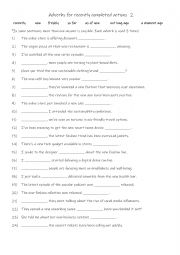
|
7 adverbs for recently completed actions 2
First, students need to familiarise themselves with the 7 adverbs. Then they read the sentences to work out which one is needed to complete the gap-fill. Each adverb is used 3 times! Answers on page 2
Level: elementary
Age: 9-100
Type:
Downloads: 104
|
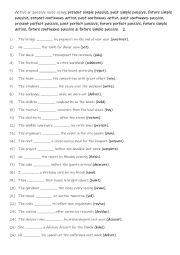
|
B1-B2 Active or passive voice using: present simple passive, past simple passive, future simple passive, present continuous active, past continuous active, past continuous passive, present perfect passive, past perfect passive, future perfect passive, fut
Students familiarise themselves with the tenses and use, then they read the sentences to work out which one is needed to complete the gap-fill using the infinitive in (). Answers on page 2.
Level: intermediate
Age: 10-100
Type:
Downloads: 107
|
|
|
|
|












